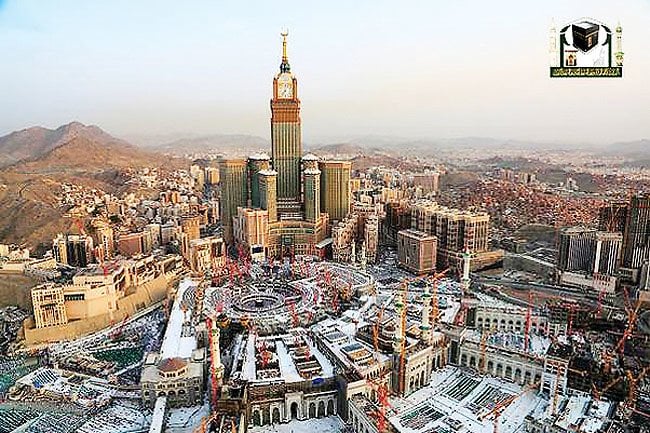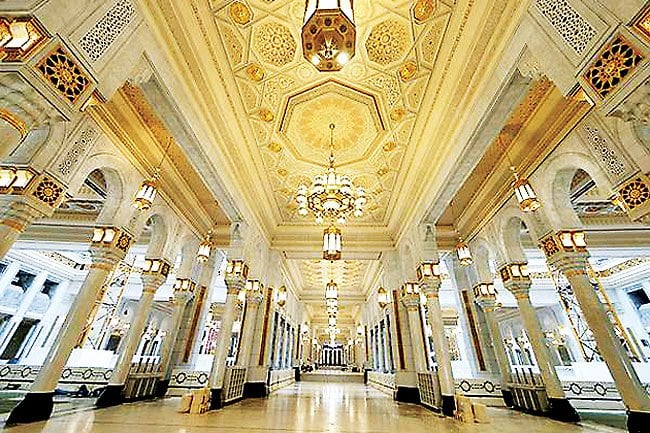Mehmood Ul Hassan Khan
 King Salman Bin Abdul Aziz is the seventh king of Saudi Arabia. He took charge as the new ruler of Saudi Arabia on January. 23, 2015 soon after the death of King Abdullah. During his 56 year tenure as governor of Riyadh, the capital city witnessed tremendous progress in all sectors. During the past months, King Salman has taken a series of decisions to strengthen the economy and enhance the Kingdom’s position in the world.
King Salman Bin Abdul Aziz is the seventh king of Saudi Arabia. He took charge as the new ruler of Saudi Arabia on January. 23, 2015 soon after the death of King Abdullah. During his 56 year tenure as governor of Riyadh, the capital city witnessed tremendous progress in all sectors. During the past months, King Salman has taken a series of decisions to strengthen the economy and enhance the Kingdom’s position in the world.
King Salman Humanitarian Aid and Relief Centre
King Salman bin Abdul Aziz launched the King Salman Humanitarian Aid and Relief Centre (Ksrelief) in May 2014 and allocated one billion Riyals (more than US$266.6 million) in addition to the previous amount provided, where the centre will assist all those in need, of all nationalities and races by providing them with relief materials and humanitarian aid. The centre has launched several relief programmes to help the brotherly people of Yemen since it was established.
Saudi Arabia’s history spans nearly three centuries, and has gone through three stages. Saudi Arabia traces its roots back to the earliest civilizations of the Arabian Peninsula. Over the centuries, the peninsula has played an important role in history as an ancient trade center and the birthplace of Islam, which is the fast spreading religious faith in the world with over 1.5 billion followers. Since King Abdul Aziz established the modern state of Saudi Arabia in 1932, its transformation has been astonishing. In a few decades, the Kingdom has turned itself from a desert nation to a modern, sophisticated state and a major player on the international stage.
1. Diplomatic Pursuits
(a) Meaningful Regional & World Engagements
To safe guard the best geopolitical and geo-strategic interests of his country, King Salman visited a number of countries, including the US, UK, China, Japan, Pakistan and India. Due to his meaningful engagements diplomatic ties further strengthened. New phase of commercial diplomacy has further strengthened socio-economic integration. Moreover, it brought new levels of better understanding between Saudi Arabia and the world’s power brokers. It reduced confusion and uncertainty about different regional and global issues of survival and productivity.
(b) Rigorous Commercial Diplomacy
His recent visit to the United States of America and meeting with President Barack Obama were significant in boosting Saudi-US relations. In March 2014, he visited to China and signed a number of agreements between the two countries. In September 2014, he visited France as crown prince and held talks with President Francois Hollande and senior French ministers to strengthen cooperation in defense, education, security, health and economic sectors. In November 2014, he led the Kingdom’s delegation to the G-20 summit in Brisbane, Australia. Saudi Arabia was the only Arab country to attend that summit conference.
2. Security Pursuits
(c) Operation Storm of Resolve
Saudi Arabia launched a massive military operation “Operation Storm of Resolve” in March 2015. It is a military operation led by Saudi Arabia with Arab and International coalitions of 10 countries against the Coup of the Houthi Group and Forces loyal to them. The Operation came in response to the request of the president of the legitimate government of Yemen Abdrabbu Mansour Hadi to stop the Houthis who launched attacks and seized the headquarters of the legitimate government by force. The International Security Council’s resolution No 2216 was issued on April 14, 2015.
(d) Operation Restoring Hope
The ongoing “Operation Restoring Hope” was aimed to resume the political process in accordance with Security Council Resolution No 2216 and the Gulf initiative and out came of the Yemeni Dialogue Conference. It was launched for the protection of civilians from Houthis’ attacks or in the event of carrying out similar attacks before Operation Storm of Resolve, and intensify the relief and medical assistance to the Yemeni people in the affected areas as well as to pave the way for international efforts to provide humanitarian assistance. It allocated US$274 million for humanitarian work in Yemen through the United Nations.
3. Conflict Resolution
(e) Syrian Crisis
The Kingdom of Saudi Arabia is supporting the brotherly People of Syria. It is also granting massive humanitarian aid too.
Sincere efforts have already been taken since the start of Syrian crisis. Detail is given below as:
(a) The Kingdom has received around 2.5 million Syrians since the beginning of the conflict.
(b) It granted them freedom of residency, movement and employment to whoever desires.
(c) They also took benefit from free education and medical care. Support and care were also extended to hundreds of thousands of Syrian refugees in neighbouring countries (Jordan and Lebanon); the aid provided by Saudi Arabia to the Syrian people totals around USD$700 million; the Kingdom has established hospitals in the Refugee camps of Hashemite, Kingdom of Jordan (Zaatari Camp) and in various border crossings points.
(f) Better Regional Understanding
Saudi Arabia is ready to settle differences with Iran. Saudi Arabia invited the Iranian foreign minister to Riyadh for the first senior meeting between the two countries. The Saudi foreign minister, Saud al-Faisal, contacted his counterpart in Tehran on after months of lower level communications between the countries, aiming to bring an end to a series of regional crises in which both are invested, principally in Syria.
Expanded Pure Islamic Services
(a) Projected Haj spending reaches SR17 billion
According to chairman of the Board of Directors of the Makkah Chamber of Commerce and Industry under the leadership of King Salman Bin Abdul Aziz the volume of spending expected during the current Haj season is approximately SR17 billion.
The government has established various projects that will shortly be completed for the benefit of pilgrims well as visitors. These projects will be inaugurated at the end of 2015 and completed within the next three years.
(b) Five Giant Projects
King Salman has started mega welfare/expansionary projects in the country especially Islamic projects. During 2015, he inaugurated five giant projects that constitute the lion’s share of the largest ever expansion in history. It included the King Abdullah Expansion Structure covering on an area of 320,000 sq. meters with a capacity to accommodate 300,000 worshippers, and courtyards expanded on a total area of 175,000 sq. meters with the capacity to hold 330,000 people.
The largest ever expansion of the Grand Mosque in Makkah is almost completed. The Prophet’s Mosque in Madinah is also witnessing a similar expansion.
(c) Five Pedestrian Tunnels
He also opened five pedestrian tunnels linking the Grand Mosque with Jarwal and Hajoun areas. Four of these tunnels are built for pilgrims and visitors while the fifth one was for emergency services and security forces. The tunnels have a total length of 5.3 km. The newly opened 4.6 km long first ring road passes through the Central Haram Area. The King also opened buildings for service facilities and that included electricity plants, reserve generators, water refrigeration facilities, disposal of trash, tanks, water pumping facilities and fire extinguishers. According to the latest report of the Ministry of Finance, which is supervising the expansion project, the remaining projects that are yet to open include buildings of the expanded mataf with their facilities, terrace buildings, security buildings, and a hospital.
(d) Expansion Works
The most important of these projects are the Mattaf and Holy Mosque expansion in Makkah Al-Mukarramah Project, and the Two Holy Mosques’ Express Train that connects between Makkah Al-Mukarramah and Madinah Al-Munawwarah Project.
The Mattaf and the Holy Mosque expansions in Makkah Al-Mukarramah Project, which will soon be announced as completed, is a testimony that the Government of the Kingdom of Saudi Arabia is giving the utmost care to projects aimed to the services of the pilgrimage of The Holy Mosque and visitors to the Nabawi Mosque in Madinah Al-Munawwarah.
Thus, these projects integrated to raise the capacity of the Mattaf to three times, reaching 100 thousand pilgrimages per hour, which will assist the pilgrimages to perform their rituals smoothly and easily.
The Two Holy Mosques’ Ex-press Train that connects Makkah Al-Mukarramah and Madinah Al-Munawwarah Project, through the city of Jeddah and King Abdullah Economic City is one of the logistical projects to secure the commuting process between the two cites which are 450 kilometres apart. The passenger terminals in these two cities were established at a capacity of 10,000 passengers per hour. The train also cut short the commute between the two cities by two and half hours.
(e) The Prophet’s Mosque
In July this year, King Salman has approved the revised designs for the Prophet’s Mosque expansion project, which includes expansion of the mosque, Darb Al-Sunnah project (3km stretch between the Prophet’s Mosque and Quba Mosque and rebuilding of the Quba Mosque). During a visit to Madinah, the King reviewed the proposals and the project’s designs within the scope of the large-scale expansion project of the Prophet’s Mosque and other related projects, which include the Dar Al-Hijra, King Salman Center for Conferences, and development of new central area in Madinah. According to the revised plan, the first phase of development works will be undertaken on the eastern side of the Prophet’s Mosque, followed by development on the western side during the second phase, the Ministry of Finance announced.
With the present massive development in the Kingdom of Saudi Arabia, its outlook and anticipation of visitors entering the Kingdom shall experience the immense growth and expansion that the Kingdom is currently undergoing in all diversities. Long live King Salman Bin Abdul Aziz.


